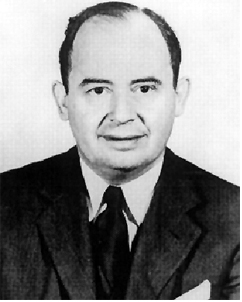Dr. John vonNeumann
 Born in Hungary in 1903, John
vonNeumann received a Ph. D. in mathematics from the University of Budapest. He immigrated to the United States in
1930, joining the faculty of Princeton University as visiting professor of mathematics and, from 1933, a member of
Princeton's Institute for Advanced Studies. He became an American citizen in 1937.
Born in Hungary in 1903, John
vonNeumann received a Ph. D. in mathematics from the University of Budapest. He immigrated to the United States in
1930, joining the faculty of Princeton University as visiting professor of mathematics and, from 1933, a member of
Princeton's Institute for Advanced Studies. He became an American citizen in 1937.
Starting in 1940, he served on the Science Advisory Committee to the Ordnance Department's Ballistics Research Laboratory (BRL) at Aberdeen Proving Ground. BRL funded the University of Pennsylvania's development of the Electronic Numerical Integrator and Computer (ENIAC), the world's first electronic computer, used for calculating firing tables for artillery and rockets. Dr. Von Neumann became an enthusiastic supporter of computer development, and when ENIAC went on line in February 1946, he persuaded the Los Alamos Scientific Laboratory to use it for completing calculations necessary for development of the hydrogen bomb.
His seminal First Draft of a Report on the EDVAC (Electronic Discrete Variable Computer), published in 1945, promoted development of this next-generation computer, one smaller yet more powerful than ENIAC and, most important, internally programmable. EDVAC was installed at BRL in 1949. Dr. Von Neumann continued his pioneering work at Princeton, where he established his Electronic Computer Project after World War II. Several new computers came from this project, directly or indirectly, to include the ORDVAC (Ordnance Variable Automatic Computer), which joined ENIAC and EDVAC at BRL's Computing Laboratory in 1952, making it the world's largest computer center at the time. These computers proved invaluable for ballistics calculations and weapons research, but also aided in weather prediction, cosmic ray studies, and wind tunnel design.
In 1952, Dr. vonNeumann served as advisor to, and in 1954 a member of, the U. S. Atomic Energy Commission. He died in 1957.